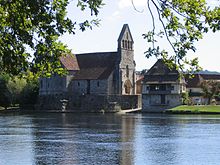Beaulieu-sur-Dordogne (Beaulieu-sur-Dordogne)
| Beaulieu-sur-Dordogne | ||
|---|---|---|

|
|
|
| local community | Beaulieu-sur-Dordogne | |
| region | Nouvelle-Aquitaine | |
| Department | Corrèze | |
| Arrondissement | Brive-la-Gaillarde | |
| Coordinates | 44 ° 59 ′ N , 1 ° 50 ′ E | |
| Post Code | 19129 | |
| Former INSEE code | 19019 | |
| Incorporation | 1st January 2019 | |
| status | Commune déléguée | |
 The Mairie of Beaulieu-sur-Dordogne |
||
Beaulieu-sur-Dordogne is a village and a former French commune with 1,142 inhabitants (as of January 1 2017) in Correze in the region Nouvelle-Aquitaine . It belonged to the Arrondissement of Brive-la-Gaillarde and the canton of Midi Corrézien .
With effect from January 1, 2019, the former municipalities of Beaulieu-sur-Dordogne and Brivezac were merged to form the Commune nouvelle Beaulieu-sur-Dordogne of the same name and have the status of a Commune déléguée in the new municipality . The administrative seat is in Beaulieu-sur-Dordogne.
location
Beaulieu is located on the western bank of the Dordogne River on the western edge of the Xaintrie Blanche . Beaulieu means in German: Beautiful place . Due to its idyllic, climatically favorable location in the valley, between forest and meadows on the bank of the river, the place bears this name.
The nearest larger towns are Brive-la-Gaillarde in the northwest, around 30 km away, and Aurillac , around 40 km in the east. 21 km upstream in the north is the picturesque former fishing town of Argentat , seven kilometers downstream, near the confluence of the Cère in the Dordogne, the place Biars-sur-Cère .
Neighboring towns are Nonards in the north, Brivezac in the northeast, Altillac in the east, Astaillac in the south and Sioniac in the west.
Population development
| year | 1962 | 1968 | 1975 | 1982 | 1990 | 1999 | 2008 | 2015 |
|---|---|---|---|---|---|---|---|---|
| Residents | 1,673 | 1,592 | 1,560 | 1,508 | 1,265 | 1,286 | 1,296 | 1,174 |
history
In 855 the Archbishop of Bourges visited the place. He was so enthusiastic about its location that he called it bellus locus (beautiful place) and founded a Benedictine abbey at this point . The Counts of Turenne and Castelnau fought bloody battles for control of the monastery in the centuries that followed. In this area of tension, the monastery and the citizens of the slowly developing settlement managed to achieve wealth and almost complete independence and to secure one privilege after another. In the 12th century the monastery was placed under the sovereignty of the Cluny monastery. Shortly before this time, the construction of the St-Pierre monastery church, which is still preserved today, began.
coat of arms
Description : Divided into red and blue. Above a silver wall at the dividing line with three equally colored towers of the same height, below a silver arm breaking out of the left edge of the shield holding a silver key , the double bit pointing to the dividing line.
Culture and sights
St. Pierre Abbey Church
The former abbey church of St-Pierre in the center of the village is one of the most important examples of Romanesque architecture in southwest France ( Monument historique ).
Penitent's Chapel
The penitential chapel ( Chapelle des Pénitents Noirs ) with its striking bell gable from the 12th century is picturesquely situated on the banks of the Dordogne and today serves as a local history museum (Monument historique).
Old town
A number of old buildings dating back to the Renaissance period have been preserved in the picturesque alleys of the old town , including the so-called Maison d'Adam et Eve , with several sculptures embedded in its outer wall.
tourism
Tourism is the main local economy. In addition to cultural tourists, the place also attracts nature lovers, canoeists and canoeists. In addition to many restaurants, hotels and guest houses, the place also offers a youth hostel, located directly on the river opposite the Chapelle des Pénitents.
Web links
Individual evidence
- ↑ Order of the Prefecture of Arrêté 19-2018-06-28-001 on the creation of the Commune nouvelle Beaulieu-sur-Dordogne of June 28, 2018 .
literature
- Auvergne - Périgord. (= The green travel guide). Michelin, Karlsruhe 2001, ISBN 2-06-000107-2 , pp. 92-93.
- Thorsten Droste : Périgord. Dordogne and Quercy - The landscapes in the heart of south-west France . DuMont, Cologne 1997, ISBN 3-7701-4003-6 , p. 81ff.

